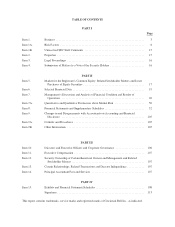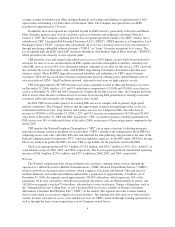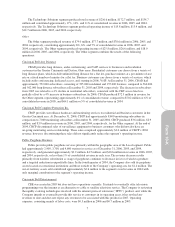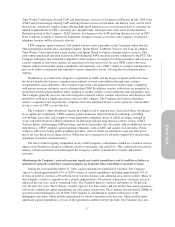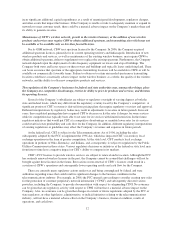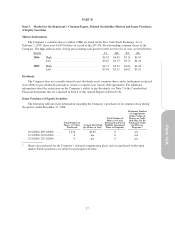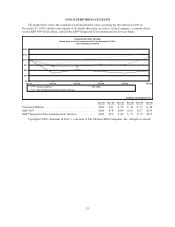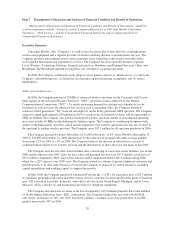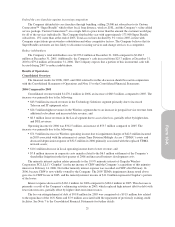Cincinnati Bell 2006 Annual Report Download - page 122
Download and view the complete annual report
Please find page 122 of the 2006 Cincinnati Bell annual report below. You can navigate through the pages in the report by either clicking on the pages listed below, or by using the keyword search tool below to find specific information within the annual report.incur significant additional capital expenditures as a result of unanticipated developments, regulatory changes,
and other events that impact the business. If the Company is unable or fails to adequately maintain or expand its
networks to meet customer needs, there could be a material adverse impact on the Company’s market share and
its ability to generate revenue.
Maintenance of CBW’s wireless network, growth in the wireless business, or the addition of new wireless
products and services may require CBW to obtain additional spectrum, and transmitting sites which may not
be available or be available only on less than favorable terms.
For its GSM network, CBW uses spectrum licensed to the Company. In 2006, the Company acquired
additional spectrum licenses, primarily for its current operating territory and Indianapolis. Introduction of new
wireless products and services, as well as maintenance of the existing wireless business, may require CBW to
obtain additional spectrum, either to supplement or to replace the existing spectrum. Furthermore, the Company
network depends upon the deployment of radio frequency equipment on towers and atop of buildings. The
Company both owns and leases spaces on these towers and buildings and typically leases underlying land. There
can be no assurance that spectrum or the appropriate transmitting locations will be available to CBW or will be
available on commercially favorable terms. Failure to obtain or to retain any needed spectrum or transmitting
locations could have a materially adverse impact on the wireless business as a whole, the quality of the wireless
networks, and the ability to offer new competitive products and services.
The regulation of the Company’s businesses by federal and state authorities may, among other things, place
the Company at a competitive disadvantage, restrict its ability to price its products and services, and threaten
its operating licenses.
Several of the Company’s subsidiaries are subject to regulatory oversight of varying degrees at both the
state and federal levels, which may differ from the regulatory scrutiny faced by the Company’s competitors. A
significant portion of CBT’s revenue is derived from pricing plans that require regulatory overview and approval.
Different interpretations by regulatory bodies may result in adjustments to revenue in future periods. In recent
years, these regulated pricing plans have required CBT to decrease or fix the rates it charges for some services
while its competition has typically been able to set rates for its services with limited restriction. In the future,
regulatory initiatives that would put CBT at a competitive disadvantage or mandate lower rates for its services
could result in lower profitability and cash flow for the Company. In addition, different regulatory interpretations
of existing regulations or guidelines may affect the Company’s revenues and expenses in future periods.
At the federal level, CBT is subject to the Telecommunications Act of 1996, including the rules
subsequently adopted by the FCC to implement the 1996 Act, which has impacted CBT’s in-territory local
exchange operations in the form of greater competition. At the state level, CBT conducts local exchange
operations in portions of Ohio, Kentucky, and Indiana, and, consequently, is subject to regulation by the Public
Utilities Commissions in those states. Various regulatory decisions or initiatives at the federal or state level may
from time to time have a negative impact on CBT’s ability to compete in its markets.
CBW’s FCC licenses to provide wireless services are subject to renewal and revocation. Although the FCC
has routinely renewed wireless licenses in the past, the Company cannot be assured that challenges will not be
brought against those licenses in the future. Revocation or non-renewal of CBW’s licenses could result in a
cessation of CBW’s operations and consequently lower operating results and cash flow for the Company.
There are currently many regulatory actions under way and being contemplated by federal and state
authorities regarding issues that could result in significant changes to the business conditions in the
telecommunications industry. For example, in 2006, the FCC opened a proceeding to consider creating new rules
for the protection of customer proprietary network information (“CPNI”) and subsequently directed various
providers, including the Company, to provide documentation with respect to safeguarding CPNI. No assurance
can be given that any regulatory activity with respect to CPNI will not have a material adverse impact on the
Company. Also, no assurance can be given that changes in current or future regulations adopted by the FCC or
state regulators, or other legislative, administrative, or judicial initiatives relating to the telecommunications
industry, will not have a material adverse effect on the Company’s business, financial condition, results of
operations, and cash flows.
12


